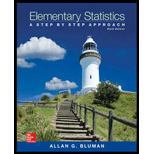
a.
To construct: The
a.
Answer to Problem 10.1.1RE
The scatterplot for the data is as follows,

Explanation of Solution
Given info:
The data represents the weekly average number of passengers per flight and the average one-way fare in dollars for common commercial routes.
Calculation:
Software procedure:
Step by step procedure to obtain scatterplot using the MINITAB software:
- Choose Graph > Scatterplot.
- Choose Simple and then click OK.
- Under Y variables, enter a column of Avg. one-way fare.
- Under X variables, enter a column of Avg. no.of passengers.
- Click OK.
b.
To compute: The value of the
b.
Answer to Problem 10.1.1RE
The value of the
Explanation of Solution
Calculation:
Correlation coefficient r:
Software Procedure:
Step-by-step procedure to obtain the ‘correlation coefficient’ using the MINITAB software:
- Select Stat >Basic Statistics > Correlation.
- In Variables, select Avg. number of passengers and Avg. one-way fare from the box on the left.
- Click OK.
Output using the MINITAB software is given below:

Thus, the value of the correlation is –0.686.
c.
To test: The significance of the correlation coefficient at
c.
Answer to Problem 10.1.1RE
The conclusion is that, there is no linear relation between the Avg. number of passengers and Avg. one-way fare.
Explanation of Solution
Given info:
The level of significance is
Calculation:
The hypotheses are given below:
Null hypothesis:
That is, there is no linear relation between the Avg. number of passengers and Avg. one-way fare.
Alternative hypothesis:
That is, there is a linear relation between the Avg. number of passengers and Avg. one-way fare.
The formula to obtain the degrees of the freedom is
That is,
From the “TABLE –I: Critical Values for the PPMC”, the critical value for 4 degrees of freedom and
Rejection Rule:
If the absolute value of r is greater than the critical value then reject the null hypothesis.
Conclusion:
From part (b), the value of the correlation of Avg. number of passengers and Avg. one-way fare is –0.686. That is the absolute value of r is 0.686.
Here, the absolute value of r is less than the critical value.
That is,
By the rejection rule, the null hypothesis is not rejected.
Therefore, there is no sufficient evidence to support the claim that “there is a linear relation between the Avg. number of passengers and Avg. one-way fare”.
d.
To find: The regression equation for the given data
d.
Answer to Problem 10.1.1RE
The regression equation for the given data is not valid.
Explanation of Solution
It is observed that the r is not significant.
Thus, the regression is not valid.
e.
To plot: The regression line on the scatter plot if appropriate.
e.
Answer to Problem 10.1.1RE
The regression line cannot be plotted in the scatterplot.
Explanation of Solution
From part (d), it is observed that the regression line is not valid.
Thus, it is inappropriate to plot the regression line on the scatter plot.
f.
To predict: The value of y for a specific value of x if appropriate.
f.
Answer to Problem 10.1.1RE
The value of y for a specific value of x is not possible.
Explanation of Solution
From part (d) the regression line is not valid.
Therefore it is not possible to predict the value of y for a specific value of x.
Want to see more full solutions like this?
Chapter 10 Solutions
Elementary Statistics: A Step By Step Approach
 MATLAB: An Introduction with ApplicationsStatisticsISBN:9781119256830Author:Amos GilatPublisher:John Wiley & Sons Inc
MATLAB: An Introduction with ApplicationsStatisticsISBN:9781119256830Author:Amos GilatPublisher:John Wiley & Sons Inc Probability and Statistics for Engineering and th...StatisticsISBN:9781305251809Author:Jay L. DevorePublisher:Cengage Learning
Probability and Statistics for Engineering and th...StatisticsISBN:9781305251809Author:Jay L. DevorePublisher:Cengage Learning Statistics for The Behavioral Sciences (MindTap C...StatisticsISBN:9781305504912Author:Frederick J Gravetter, Larry B. WallnauPublisher:Cengage Learning
Statistics for The Behavioral Sciences (MindTap C...StatisticsISBN:9781305504912Author:Frederick J Gravetter, Larry B. WallnauPublisher:Cengage Learning Elementary Statistics: Picturing the World (7th E...StatisticsISBN:9780134683416Author:Ron Larson, Betsy FarberPublisher:PEARSON
Elementary Statistics: Picturing the World (7th E...StatisticsISBN:9780134683416Author:Ron Larson, Betsy FarberPublisher:PEARSON The Basic Practice of StatisticsStatisticsISBN:9781319042578Author:David S. Moore, William I. Notz, Michael A. FlignerPublisher:W. H. Freeman
The Basic Practice of StatisticsStatisticsISBN:9781319042578Author:David S. Moore, William I. Notz, Michael A. FlignerPublisher:W. H. Freeman Introduction to the Practice of StatisticsStatisticsISBN:9781319013387Author:David S. Moore, George P. McCabe, Bruce A. CraigPublisher:W. H. Freeman
Introduction to the Practice of StatisticsStatisticsISBN:9781319013387Author:David S. Moore, George P. McCabe, Bruce A. CraigPublisher:W. H. Freeman





